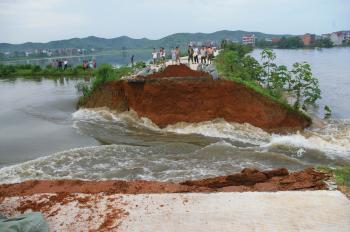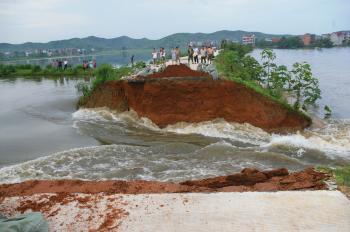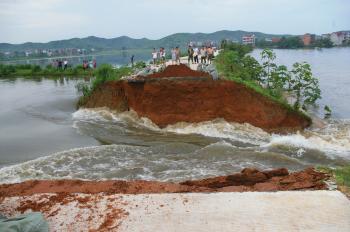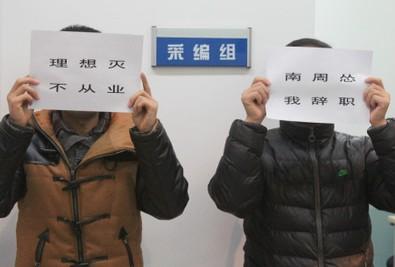Severe flooding in southern China has put in question the flood-control and other functions of China’s most ambitious, costliest, and controversial water-control project—the Three Gorges Dam.
At 8 a.m. on July 20, China’s Three Gorges Dam on the Yangtze River had the highest peak flow since its completion. Water flowed into the dam at 70,000 cubic meters per second. Nine of the dam’s discharge channels were opened to release the floodwater from upstream to downstream of the dam.
Official media claimed that the Three Gorges Dam has stood up to its biggest flood-control test since completion, as the flow on the river’s upper reaches tops 70,000 cubic meters per second—20,000 cubic meters more than the flow during the 1998 floods that killed 4,150 people.
However, the “flood-control test” is far from over yet, as some of the already flood-stricken areas in the lower reaches of the dam are still fighting floodwaters.
Due to the floodwater released from the Three Gorges Dam and the torrential rains, the water level in the downstream Yangtze River in Hubei Province rose above the alert level along 628 miles of dikes on July 22. The water level of five major lakes and 603 dams in Hubei Province were also above the flood level, Wuhan Morning Post reported on July 23.
In another lower reach of the Yangtze River, a 300- to 500-meter-long (0.2 to 0.3 mile) stretch of riverbank in Mianchuan Island, (Jiangzhou Township, Jiujiang City, Jiangxi Province) collapsed on July 18 due to the rising Yangtze River.
On July 23 state-run media reported that the flooding on Mianchuan Island was so severe that residents feared a repeat of the massive floods of 1998 when the flood discharge from the Three Gorges Dam reached Jiujiang City on July 25. In the 1998 flood, the dikes in Jiangzhou Township breached, and many people had to evacuate the area. (http://news.bbc.co.uk/2/hi/asia-pacific/146455.stm)
As of July 21, at least 701 people have died and 347 are missing due to flooding in southern China, according to official reports.
A villager in Jiangxin Village on Mianchuan Island told an Epoch Times reporter on July 18 that most farmland close to the big dikes had been devoured by flood waters, and he has lost all the crops he had planted for the year. He said he has been hit by floods for three years in a row, and this flood could be as bad as the one in 1998.
At this critical time, with so many communities at risk, the Three Gorges Dam is releasing water from the reservoir at an accelerated rate. The release of floodwater into the lower reaches of the river in a flood season has raised doubts about the “flood control” function of the Three Gorges Dam.
The late Huang Wanli (1911–2001), a professor in the Hydraulic Engineering Department of Tsinghua University, was an opponent of the Three Gorges Dam construction since the 1990s. He had long predicated that the dam would regulate water in a “reversed way”—sluicing water out of the reservoir during the rainy season, when it is supposed to store water, and storing water during the dry season, when it is supposed to release water.
At 8 a.m. on July 20, China’s Three Gorges Dam on the Yangtze River had the highest peak flow since its completion. Water flowed into the dam at 70,000 cubic meters per second. Nine of the dam’s discharge channels were opened to release the floodwater from upstream to downstream of the dam.
Official media claimed that the Three Gorges Dam has stood up to its biggest flood-control test since completion, as the flow on the river’s upper reaches tops 70,000 cubic meters per second—20,000 cubic meters more than the flow during the 1998 floods that killed 4,150 people.
However, the “flood-control test” is far from over yet, as some of the already flood-stricken areas in the lower reaches of the dam are still fighting floodwaters.
Due to the floodwater released from the Three Gorges Dam and the torrential rains, the water level in the downstream Yangtze River in Hubei Province rose above the alert level along 628 miles of dikes on July 22. The water level of five major lakes and 603 dams in Hubei Province were also above the flood level, Wuhan Morning Post reported on July 23.
In another lower reach of the Yangtze River, a 300- to 500-meter-long (0.2 to 0.3 mile) stretch of riverbank in Mianchuan Island, (Jiangzhou Township, Jiujiang City, Jiangxi Province) collapsed on July 18 due to the rising Yangtze River.
On July 23 state-run media reported that the flooding on Mianchuan Island was so severe that residents feared a repeat of the massive floods of 1998 when the flood discharge from the Three Gorges Dam reached Jiujiang City on July 25. In the 1998 flood, the dikes in Jiangzhou Township breached, and many people had to evacuate the area. (http://news.bbc.co.uk/2/hi/asia-pacific/146455.stm)
As of July 21, at least 701 people have died and 347 are missing due to flooding in southern China, according to official reports.
A villager in Jiangxin Village on Mianchuan Island told an Epoch Times reporter on July 18 that most farmland close to the big dikes had been devoured by flood waters, and he has lost all the crops he had planted for the year. He said he has been hit by floods for three years in a row, and this flood could be as bad as the one in 1998.
Reverse Flood Control
At this critical time, with so many communities at risk, the Three Gorges Dam is releasing water from the reservoir at an accelerated rate. The release of floodwater into the lower reaches of the river in a flood season has raised doubts about the “flood control” function of the Three Gorges Dam.
The late Huang Wanli (1911–2001), a professor in the Hydraulic Engineering Department of Tsinghua University, was an opponent of the Three Gorges Dam construction since the 1990s. He had long predicated that the dam would regulate water in a “reversed way”—sluicing water out of the reservoir during the rainy season, when it is supposed to store water, and storing water during the dry season, when it is supposed to release water.





